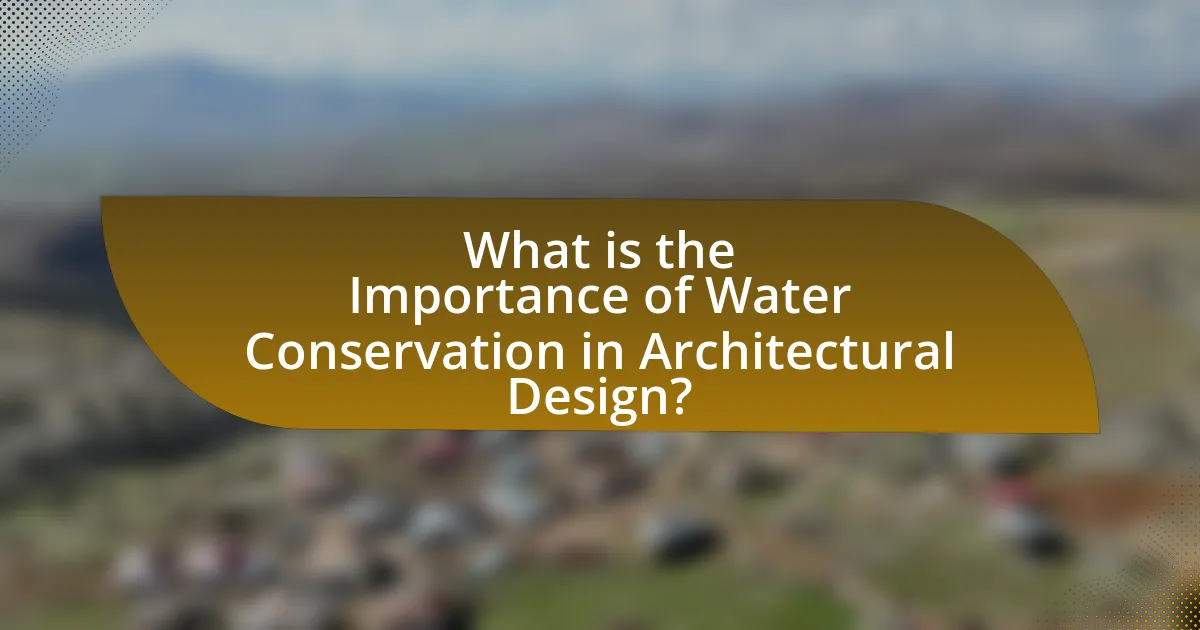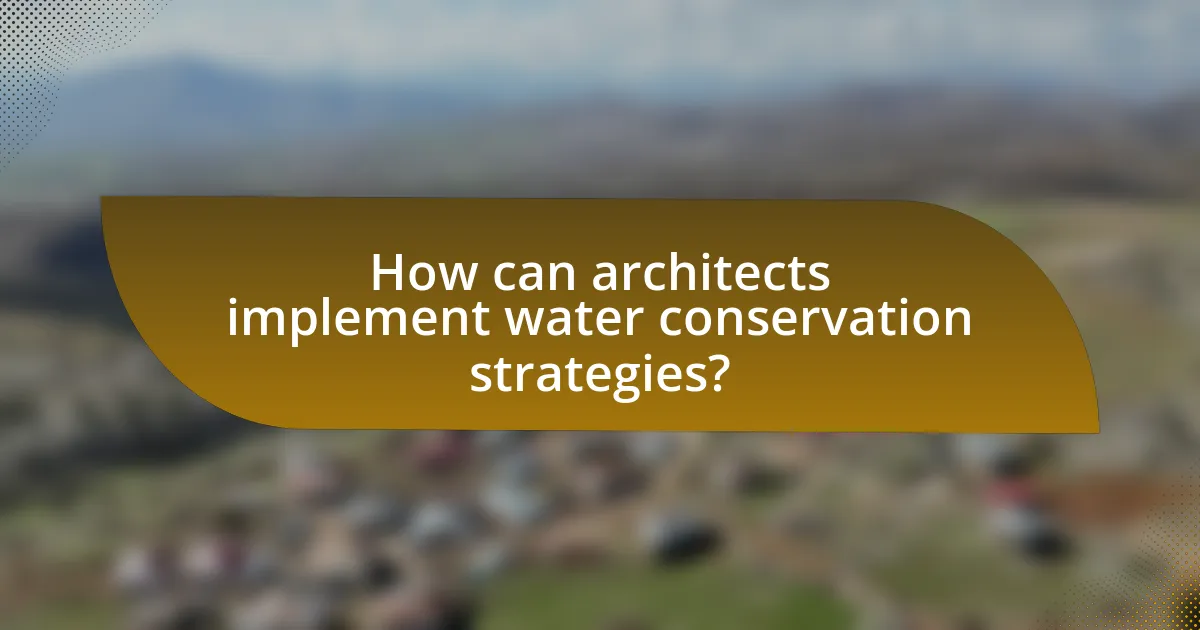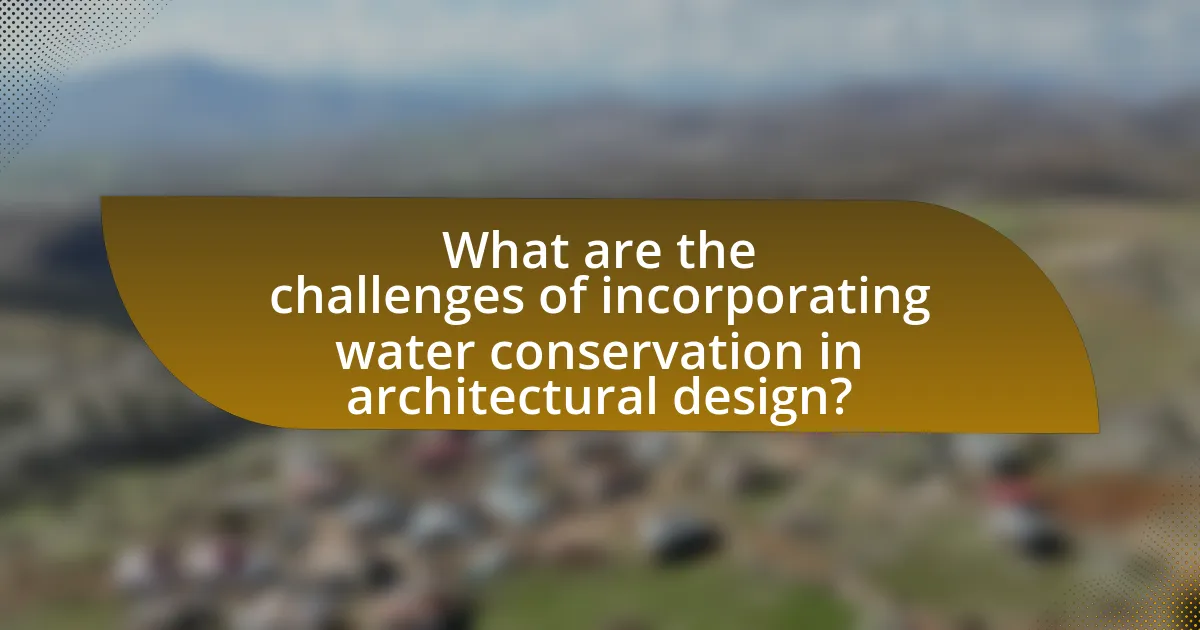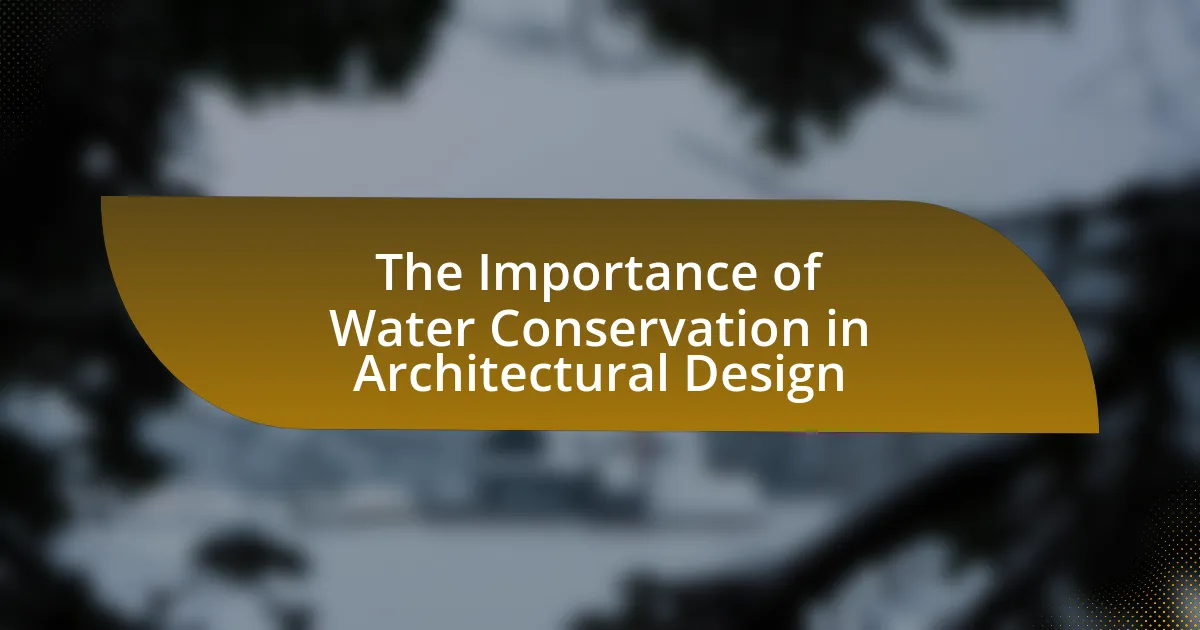Water conservation in architectural design is essential for promoting sustainable development and efficient resource management. The article highlights the significant impact of buildings on water usage, accounting for nearly 12% of total water consumption in the United States. It discusses various strategies for reducing water waste, such as rainwater harvesting, drought-resistant landscaping, and low-flow fixtures, which not only lower utility costs but also enhance community resilience against water scarcity. Additionally, the article addresses the environmental consequences of water waste, the role of water conservation in urban planning, and the challenges architects face in implementing these practices, emphasizing the importance of collaboration and community involvement in achieving effective water conservation outcomes.

What is the Importance of Water Conservation in Architectural Design?
Water conservation in architectural design is crucial for sustainable development and resource management. It minimizes water waste, reduces environmental impact, and promotes efficient use of water resources in buildings. According to the U.S. Environmental Protection Agency, buildings account for nearly 12% of total water use in the United States, highlighting the need for water-efficient designs. Implementing features such as rainwater harvesting systems, drought-resistant landscaping, and low-flow fixtures can significantly decrease water consumption. These strategies not only lower utility costs for occupants but also contribute to the overall resilience of communities against water scarcity.
Why is water conservation critical in the context of architecture?
Water conservation is critical in architecture because it directly impacts sustainability and resource management in building design. Efficient water use reduces the demand on local water supplies, which is essential in areas facing water scarcity; for instance, buildings designed with water-efficient fixtures can save up to 30% more water compared to traditional designs. Additionally, incorporating rainwater harvesting systems and greywater recycling in architectural plans can significantly lower water consumption, promoting environmental stewardship and reducing utility costs for occupants. These practices not only contribute to the longevity of water resources but also align with global sustainability goals, such as those outlined in the United Nations Sustainable Development Goals, specifically Goal 6, which emphasizes the importance of clean water and sanitation.
What are the environmental impacts of water waste in buildings?
Water waste in buildings significantly contributes to environmental degradation by depleting freshwater resources and increasing energy consumption. When water is wasted, it leads to higher demand for water extraction, which can result in habitat destruction and reduced biodiversity in aquatic ecosystems. Additionally, the energy required to pump, treat, and distribute water increases greenhouse gas emissions, exacerbating climate change. According to the U.S. Environmental Protection Agency, buildings account for nearly 12% of total water use in the United States, highlighting the substantial impact of water waste on both local and global scales.
How does water conservation contribute to sustainable architecture?
Water conservation significantly contributes to sustainable architecture by reducing the overall demand for water resources, which is essential for maintaining ecological balance. Sustainable architecture incorporates water-efficient systems, such as rainwater harvesting and greywater recycling, which minimize water usage and promote responsible consumption. According to the U.S. Environmental Protection Agency, buildings account for nearly 12% of total water use in the United States, highlighting the potential impact of water conservation strategies in reducing this footprint. By integrating these practices, architects can design structures that not only lower operational costs but also enhance resilience against water scarcity, thereby supporting long-term sustainability goals.
What role does water conservation play in urban planning?
Water conservation plays a critical role in urban planning by ensuring sustainable management of water resources, which is essential for supporting growing populations and mitigating environmental impacts. Effective urban planning incorporates water-efficient designs, such as green infrastructure, which can reduce runoff and enhance groundwater recharge. For instance, cities that implement rainwater harvesting systems and permeable pavements can significantly decrease water demand and improve resilience against flooding. According to the U.S. Environmental Protection Agency, implementing water-efficient practices can reduce urban water use by up to 30%, demonstrating the tangible benefits of integrating water conservation into urban planning strategies.
How can architectural design influence water management in cities?
Architectural design can significantly influence water management in cities by integrating sustainable practices such as rainwater harvesting, green roofs, and permeable surfaces. These design elements facilitate the collection and utilization of rainwater, reducing runoff and promoting groundwater recharge. For instance, buildings designed with green roofs can absorb rainwater, which mitigates flooding and lowers the demand on stormwater systems. Additionally, permeable pavements allow water to infiltrate the ground, decreasing surface runoff and enhancing water quality. Studies have shown that cities implementing these architectural strategies can reduce stormwater runoff by up to 50%, demonstrating the effectiveness of thoughtful design in managing urban water resources.
What are the benefits of integrating water conservation into urban infrastructure?
Integrating water conservation into urban infrastructure significantly enhances sustainability and resource efficiency. This approach reduces water consumption, minimizes wastewater generation, and lowers the demand on municipal water supplies. For instance, cities that implement rainwater harvesting systems can decrease their reliance on treated water by up to 30%, as demonstrated in studies conducted by the American Society of Civil Engineers. Additionally, incorporating green roofs and permeable pavements can improve stormwater management, reducing flooding risks and promoting groundwater recharge. These strategies not only conserve water but also contribute to urban resilience against climate change impacts.

How can architects implement water conservation strategies?
Architects can implement water conservation strategies by incorporating efficient plumbing systems, utilizing rainwater harvesting, and designing landscapes with drought-resistant plants. Efficient plumbing systems reduce water waste through low-flow fixtures and smart irrigation controls, which can decrease water usage by up to 30%. Rainwater harvesting systems capture and store rainwater for irrigation and non-potable uses, potentially providing up to 50% of a building’s water needs. Additionally, selecting native and drought-resistant plants in landscaping minimizes irrigation requirements, further promoting water conservation. These strategies collectively contribute to sustainable architectural practices and significantly reduce overall water consumption.
What design techniques promote water efficiency in buildings?
Design techniques that promote water efficiency in buildings include the implementation of low-flow fixtures, rainwater harvesting systems, and xeriscaping. Low-flow fixtures, such as faucets, showerheads, and toilets, significantly reduce water consumption by using advanced technology to limit flow rates without sacrificing performance. Rainwater harvesting systems capture and store rainwater for non-potable uses, such as irrigation and toilet flushing, which can reduce reliance on municipal water supplies. Xeriscaping involves landscaping with drought-resistant plants, minimizing the need for irrigation and promoting sustainable water use. These techniques collectively contribute to a substantial decrease in water usage, aligning with sustainable building practices and environmental conservation goals.
How do rainwater harvesting systems work in architectural design?
Rainwater harvesting systems in architectural design collect and store rainwater for various uses, thereby promoting water conservation. These systems typically involve the installation of catchment surfaces, such as roofs, which direct rainwater into gutters and downspouts. The collected water is then channeled into storage tanks or cisterns, where it can be filtered and treated for non-potable uses like irrigation, toilet flushing, or cooling systems.
Architectural design integrates these systems by incorporating features such as sloped roofs and strategically placed drainage systems to maximize water collection efficiency. According to the U.S. Environmental Protection Agency, rainwater harvesting can reduce reliance on municipal water supplies and decrease stormwater runoff, contributing to sustainable building practices.
What are the advantages of using drought-resistant landscaping?
Drought-resistant landscaping offers significant advantages, primarily in water conservation and reduced maintenance costs. This type of landscaping utilizes native and adapted plants that require less water, thereby conserving valuable water resources, especially in arid regions. According to the U.S. Environmental Protection Agency, implementing drought-resistant landscaping can reduce outdoor water use by 20-50%. Additionally, these landscapes often require less frequent mowing, fertilization, and pest control, leading to lower maintenance costs and less environmental impact. Furthermore, drought-resistant plants are typically more resilient to local climate conditions, enhancing the sustainability of the landscape over time.
What technologies support water conservation in architecture?
Technologies that support water conservation in architecture include rainwater harvesting systems, greywater recycling systems, and smart irrigation technologies. Rainwater harvesting systems collect and store rainwater for non-potable uses, significantly reducing reliance on municipal water supplies. Greywater recycling systems treat and reuse water from sinks, showers, and washing machines for irrigation and toilet flushing, which can save up to 50% of water usage in buildings. Smart irrigation technologies utilize sensors and weather data to optimize water usage in landscaping, ensuring that plants receive the right amount of water without waste. These technologies collectively contribute to sustainable architectural practices by minimizing water consumption and promoting efficient resource management.
How do smart water management systems enhance conservation efforts?
Smart water management systems enhance conservation efforts by optimizing water usage through real-time monitoring and data analysis. These systems utilize sensors and IoT technology to track water consumption patterns, detect leaks, and manage irrigation schedules efficiently. For instance, a study by the American Water Works Association found that implementing smart water management can reduce water waste by up to 30%, significantly contributing to conservation goals. By providing actionable insights, these systems enable users to make informed decisions, ultimately leading to more sustainable water practices in architectural design and urban planning.
What role do low-flow fixtures play in reducing water consumption?
Low-flow fixtures significantly reduce water consumption by limiting the amount of water used in plumbing systems without sacrificing performance. These fixtures, such as low-flow toilets, showerheads, and faucets, are designed to use less water while maintaining adequate pressure and flow rates. For instance, low-flow toilets can use as little as 1.28 gallons per flush compared to traditional models that use up to 3.5 gallons, resulting in substantial water savings. According to the U.S. Environmental Protection Agency, replacing older fixtures with low-flow alternatives can save an average household over 20,000 gallons of water annually. This reduction in water usage not only conserves a vital resource but also decreases the energy required for water heating and treatment, further enhancing overall sustainability in architectural design.

What are the challenges of incorporating water conservation in architectural design?
Incorporating water conservation in architectural design presents several challenges, including the need for innovative technologies, higher initial costs, and regulatory compliance. Innovative technologies, such as rainwater harvesting systems and greywater recycling, require specialized knowledge and expertise, which can complicate the design process. Higher initial costs often deter architects and clients from implementing water-saving features, despite long-term savings on water bills. Additionally, navigating local regulations and building codes can pose obstacles, as these may not always support or incentivize water conservation measures. These challenges highlight the complexities architects face when striving to integrate sustainable water practices into their designs.
What barriers do architects face in implementing water-saving measures?
Architects face several barriers in implementing water-saving measures, including regulatory constraints, budget limitations, and a lack of awareness or education about sustainable practices. Regulatory constraints often arise from building codes and zoning laws that do not prioritize or incentivize water conservation technologies. Budget limitations can restrict the ability to invest in advanced water-saving systems, as initial costs may be higher than traditional options. Additionally, a lack of awareness among clients and stakeholders about the benefits of water-saving measures can hinder architects from advocating for these solutions effectively. According to a study by the American Institute of Architects, 70% of architects reported that client budget concerns were a significant barrier to implementing sustainable design features, including water conservation measures.
How can cost considerations impact water conservation efforts?
Cost considerations significantly impact water conservation efforts by influencing the feasibility and implementation of conservation technologies and practices. When financial resources are limited, stakeholders may prioritize immediate economic benefits over long-term sustainability, leading to reduced investment in water-efficient systems. For instance, a study by the American Society of Civil Engineers found that every dollar invested in water conservation can yield up to $5 in savings on water supply and treatment costs. This demonstrates that while upfront costs may deter investment, the long-term financial benefits can justify the initial expenditure, ultimately enhancing water conservation initiatives.
What regulatory challenges exist for water conservation in architecture?
Regulatory challenges for water conservation in architecture include inconsistent building codes, lack of standardized guidelines, and limited incentives for sustainable practices. In many regions, building codes do not adequately address water-efficient technologies, leading to ambiguity in implementation. Additionally, the absence of uniform standards across jurisdictions complicates compliance for architects and builders, hindering the adoption of innovative water-saving solutions. Furthermore, financial incentives for water conservation measures are often insufficient, discouraging investment in sustainable design. These challenges collectively impede the effective integration of water conservation strategies in architectural projects.
How can collaboration enhance water conservation in architectural projects?
Collaboration can enhance water conservation in architectural projects by integrating diverse expertise and perspectives, leading to innovative solutions. When architects, engineers, landscape designers, and environmental specialists work together, they can identify and implement water-efficient technologies and practices, such as rainwater harvesting systems and drought-resistant landscaping. For instance, a study by the American Institute of Architects found that collaborative design processes can reduce water usage by up to 30% in new buildings. This collective approach not only fosters creativity but also ensures that water conservation strategies are effectively tailored to the specific environmental context of each project.
What partnerships are essential for successful water conservation initiatives?
Successful water conservation initiatives require partnerships between government agencies, non-profit organizations, private sector companies, and local communities. Government agencies provide regulatory frameworks and funding, while non-profit organizations often lead educational campaigns and community engagement efforts. Private sector companies can contribute technology and innovation for efficient water use, and local communities are essential for grassroots support and implementation of conservation practices. For instance, the collaboration between the Environmental Protection Agency and local water districts has led to significant reductions in water usage through programs like WaterSense, which promotes water-efficient products and practices.
How can community involvement improve water conservation outcomes?
Community involvement can significantly improve water conservation outcomes by fostering collective responsibility and awareness among residents. When communities actively participate in water conservation initiatives, they are more likely to adopt sustainable practices, such as rainwater harvesting and xeriscaping. Research shows that community-led programs can lead to a 20-30% reduction in water usage, as seen in various municipalities that implemented local conservation campaigns. Engaging residents through workshops and educational programs enhances their understanding of water scarcity issues, motivating them to take action. This collaborative approach not only increases the effectiveness of conservation efforts but also builds a sense of ownership and accountability within the community.
What best practices should architects follow for effective water conservation?
Architects should implement rainwater harvesting systems as a best practice for effective water conservation. This approach allows for the collection and storage of rainwater for non-potable uses, significantly reducing reliance on municipal water supplies. According to the U.S. Environmental Protection Agency, rainwater harvesting can reduce water consumption by up to 50% in some applications. Additionally, architects should design landscapes with native and drought-resistant plants, which require less irrigation and promote sustainable water use. The use of permeable paving materials can also enhance groundwater recharge and minimize runoff, further supporting water conservation efforts.
How can architects stay updated on water conservation technologies?
Architects can stay updated on water conservation technologies by engaging in continuous education through workshops, webinars, and industry conferences focused on sustainable design. These events often feature the latest innovations and best practices in water conservation, allowing architects to learn from experts and network with peers. Additionally, subscribing to relevant journals and publications, such as the Journal of Water Resources Planning and Management, provides access to research studies and case studies that highlight advancements in water-saving technologies. Furthermore, joining professional organizations like the American Institute of Architects (AIA) can offer resources and updates on emerging trends in water conservation.
What resources are available for architects to learn about water-efficient design?
Architects can access various resources to learn about water-efficient design, including online courses, professional organizations, and publications. Online platforms like Coursera and edX offer courses specifically focused on sustainable architecture and water conservation techniques. Professional organizations such as the American Institute of Architects (AIA) and the U.S. Green Building Council (USGBC) provide guidelines, webinars, and workshops on water-efficient practices. Additionally, publications like “Water-Efficient Landscape Design” by the EPA and “Sustainable Water Management in the Built Environment” offer in-depth insights and case studies that reinforce the importance of water conservation in architectural design.
